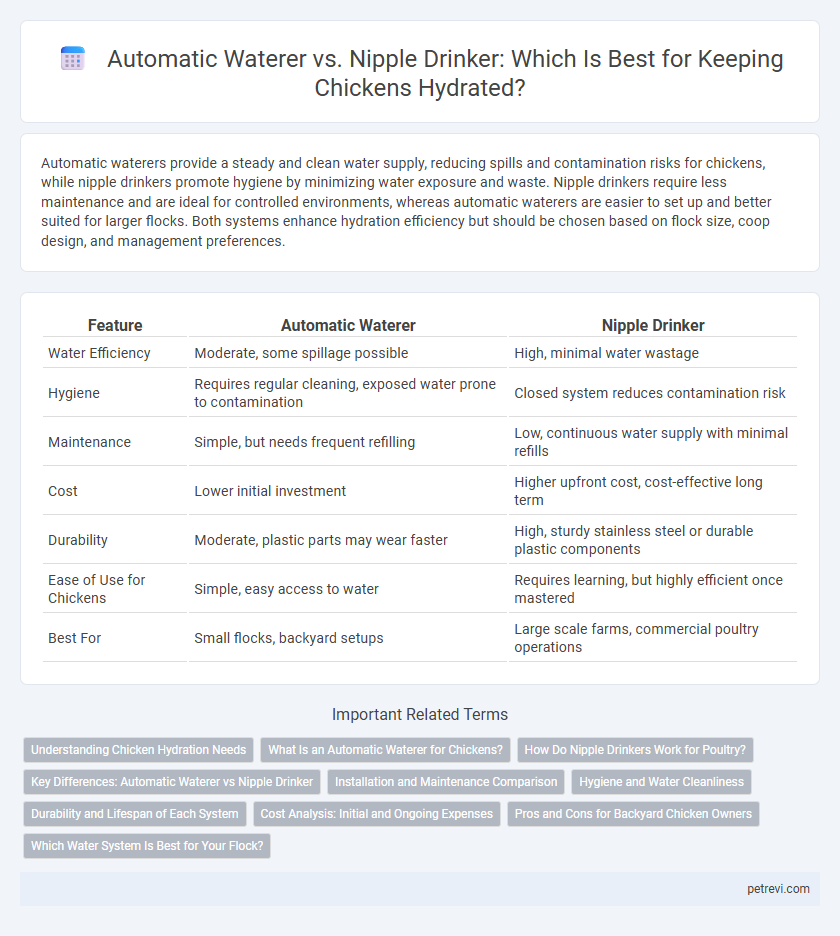Automatic waterers provide a steady and clean water supply, reducing spills and contamination risks for chickens, while nipple drinkers promote hygiene by minimizing water exposure and waste. Nipple drinkers require less maintenance and are ideal for controlled environments, whereas automatic waterers are easier to set up and better suited for larger flocks. Both systems enhance hydration efficiency but should be chosen based on flock size, coop design, and management preferences.
Table of Comparison
| Feature | Automatic Waterer | Nipple Drinker |
|---|---|---|
| Water Efficiency | Moderate, some spillage possible | High, minimal water wastage |
| Hygiene | Requires regular cleaning, exposed water prone to contamination | Closed system reduces contamination risk |
| Maintenance | Simple, but needs frequent refilling | Low, continuous water supply with minimal refills |
| Cost | Lower initial investment | Higher upfront cost, cost-effective long term |
| Durability | Moderate, plastic parts may wear faster | High, sturdy stainless steel or durable plastic components |
| Ease of Use for Chickens | Simple, easy access to water | Requires learning, but highly efficient once mastered |
| Best For | Small flocks, backyard setups | Large scale farms, commercial poultry operations |
Understanding Chicken Hydration Needs
Automatic waterers provide a consistent water supply that meets chickens' hydration needs by ensuring easy access and reducing contamination risks. Nipple drinkers promote cleanliness by minimizing water spillage and keeping the coop dry, which is essential for healthy chicken environments. Proper hydration supports optimal digestion and egg production, making the choice between these systems crucial for efficient poultry management.
What Is an Automatic Waterer for Chickens?
An automatic waterer for chickens is a device designed to provide a continuous and clean water supply without frequent manual refilling. These systems typically use gravity or pressure mechanisms to deliver water into a trough or basin, ensuring chickens have constant hydration. Automatic waterers reduce water spillage and contamination, promoting better flock health and ease of maintenance.
How Do Nipple Drinkers Work for Poultry?
Nipple drinkers provide poultry with clean, fresh water by releasing water only when birds peck at the metal pin, minimizing spillage and contamination. These devices are connected to a water supply system, ensuring constant availability and reducing the risk of wet bedding and disease. Their efficient design promotes hygiene and conserves water compared to automatic waterers, making them ideal for modern poultry hydration systems.
Key Differences: Automatic Waterer vs Nipple Drinker
Automatic waterers provide a continuous, gravity-fed water supply through an open bowl or trough, ensuring easy access but increasing the risk of contamination and spillage. Nipple drinkers dispense water only when chickens peck at them, reducing water waste and contamination by limiting exposure to open water surfaces. Key differences include maintenance requirements, water efficiency, and hygiene, with nipple drinkers typically promoting cleaner water and lower consumption compared to automatic waterers.
Installation and Maintenance Comparison
Installing an automatic waterer for chicken hydration generally requires a simple connection to a water source with basic tools, making it quick and straightforward for backyard setups. Nipple drinkers need precise placement at chicken height and secure mounting to prevent leaks, which can demand more careful adjustment and expertise. Maintenance for automatic waterers involves regular cleaning to prevent algae buildup, while nipple drinkers require frequent inspection and occasional replacement of nipples to ensure consistent water flow and hygiene.
Hygiene and Water Cleanliness
Automatic waterers provide a larger water surface area that can become easily contaminated by dirt and chicken droppings, increasing the risk of bacterial growth and disease. Nipple drinkers offer a more hygienic solution by delivering water directly to the chicken's beak, minimizing exposure to contaminants and maintaining cleaner water quality. Studies show nipple drinkers reduce water wastage and significantly lower pathogen exposure compared to traditional automatic waterers.
Durability and Lifespan of Each System
Automatic waterers typically feature robust plastic or metal construction designed to withstand harsh outdoor conditions, offering a lifespan of 3 to 5 years with proper maintenance. Nipple drinkers, made from stainless steel or high-grade plastic, provide superior durability against rust and wear, often lasting 5 to 7 years or more. Choosing nipple drinkers can reduce frequent replacements due to their corrosion resistance and longevity, making them a cost-effective option for long-term chicken hydration systems.
Cost Analysis: Initial and Ongoing Expenses
Automatic waterers typically require a higher initial investment, ranging from $50 to $150, due to their complex design and installation needs, whereas nipple drinkers cost between $20 and $60, making them more budget-friendly upfront. Ongoing expenses for automatic waterers can be moderate, including electricity for pumps and periodic maintenance, while nipple drinkers incur lower maintenance costs but may need frequent replacements of small parts to prevent clogging. Evaluating both initial and recurring costs is crucial for poultry farmers aiming to balance efficiency and budget in chicken hydration systems.
Pros and Cons for Backyard Chicken Owners
Automatic waterers provide a consistent water supply and reduce labor for backyard chicken owners, minimizing spillage and contamination risks. Nipple drinkers promote cleaner water by preventing exposure to dirt and debris but require proper installation and maintenance to avoid clogging. Both options improve chicken hydration efficiency, yet automatic waterers may lead to more waste, while nipple drinkers can limit water access if not positioned correctly.
Which Water System Is Best for Your Flock?
Automatic waterers provide a steady water supply, reducing contamination risk by limiting open water exposure, while nipple drinkers promote hygiene by allowing chickens to drink directly from a clean source. Nipple drinkers are often preferred for their efficiency, water conservation, and ease of maintenance, making them ideal for larger or confined flocks. Selecting the best system depends on flock size, coop setup, and management preferences to ensure optimal hydration and health.
Automatic Waterer vs Nipple Drinker for Chicken Hydration Infographic

 petrevi.com
petrevi.com